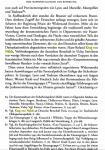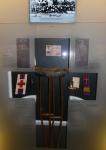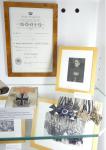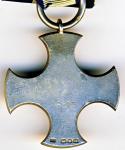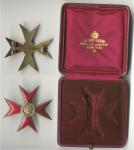-
Posts
2,868 -
Joined
-
Last visited
-
Days Won
20
Content Type
Profiles
Forums
Blogs
Gallery
Events
Store
Everything posted by Claudio
-
I don't know if you have noticed, but it's a tuxedo/civilian court mounted bar (in German Frackspange). The order of the decorations is accetable for a bar put together in the 20ies-early 30ies, according the Saxon fashion to wear first their "National" awards in front of the others awards of the other German states. Ciao, Claudio
-
Hi Roman, I remember to have seen the first bar some years ago on Ebay, the whole group being sold in small bits... I clearly remember that there was a Miniature bar (for civilian tuxedo), some more Freikorps crosses and civil war decorations of the 20ies (neck and breast pin crosses)... I distinctly recall that all these pieces went for a very high final price! I'd ask the seller if he has more stuff of the same group. Ciao, Claudio
-

Finland New Finnish Medal Bars W/ German Decorations
Claudio replied to Jani Tiainen's topic in Northern European & Baltic States
Hi Vince, The first medal is the Medal of Liberty: Associated with the Cross of Liberty and instituted at the same time, on 4 March 1918, by the Senate at Wasa. The medal was created in two classes, the 1st class in silver (blue ribbon with thin white side stripes, the 2nd class in bronze, (scarlet ribbon with broad yellow stripes) for award to noncoms and other ranks for bravery in the field. The obverse shows the head of a crowned Finnish lion, raising a paw holding a sword. Around the edge are the words "URHEUDESTA FÖR TAPPERHET" (For Bravery, in Finnish and Swedish). The reverse has a laurel wreath surrounding the text "SUOMEN / KANSALTA / 1918" (From the people of Finland). The second medal is the Commemorative Medal of the War of Liberation: Awarded to all who had participated in the war to secure Finland's independance. Instituted on 10 September 1918 by the Finnish Senate in Helsinki, this blackened iron medal was originally decreed to hang from a dark blue ribbon. In order to avoid confusion with the Order of the White Rose's ribbon, General Mannerheim decided on 3 July 1919 to have this medal's ribbon altered and black side stripes were adopted. On the same day a silver heraldic rose was instituted for wearing on the ribbon in case of an award for bravery. Equally instituted that day were 11 silver bars bearing the names of actions in which the recipient had participated: OESTERBOTTENS KARALIAN FRONT FILPULA VIBORG TAMMERFORS LEMPAALA-LAHTIS SATAKUNTA PELLINGE SAVOLAX SYD FINLAND KOUVOLA-KOTKA-FREDRIKSHAMM The obverse shows the Finnish arms, a crowned rampant lion standing on a curved sword and holding a broken sword in its raised paw. The reverse shows the Cross of Liberty with in each of the upper angles an armoured arm holding a sword (as in the Cross's Military Division suspension). In the lower angles is the year "19 / 18". Note: The medal shown is in a white metal rather than blackened iron. It is possible that this example was manufactured in Germany. Many members of the German Baltic Division participated in the liberation, and so would have been in line for the medal. If an actual Finnish issue medal (in blackened iron) was unavailable, a German-made copy may have sufficed. Quotes from http://www.gwpda.org/medals/finmedl/finland.html Ciao, Claudio -
Dear forumites, Visiting Munich and some of the beautiful re-constructed churches shamefully and utterly destroyed during WW2, I had the opportunity to go to the Bürgersaalkirche where lies the remains of the Blessed Rupert Mayer ( http://en.wikipedia.org/wiki/Rupert_Mayer ) and a museum about his life. I was surprised to see that there were also his medals and pictures of WW1 exposed; Mayer served in the East Front and lost his left leg in 1916. The world needs more people like Blessed Pater Mayer; he once said that a Christian could never be a Nationalsocialist... Although the regime has prohibited him to preach and spread the God's word in public (Redeverbot), he was consequent until the very end to his beliefs and was arrested many times and spent some time in the KZ in Sachsenhausen. Let's honour him and all the people with civil courage against dictaturship, oppresion and for the freedom of speech. Merry Christmas to all forumites! Claudio P.S.: notice the ribbon on the BMVO 4 mit Kr. u. X... ;-)
-
All these ribbons, since they come to the end of the bars, are obviously foreign (non-dutch orders). The one with gold crown device and black ribbon could be the Order of the Northern (or Polar) Star (Sweden), http://en.wikipedia.org/wiki/Order_of_the_Polar_Star The ones with the rosette devices could be French or Belgian orders. The pale blue ribbon could be a Ex-French Colonial order (ordre de l'étoile noire), see http://fr.wikipedia.org/wiki/Ordre_de_l'%C3%89toile_noire, the rosette with white/silver colour backing would indicate the class (commander). The blue/red/blue ribbon with rosette could be l'ordre du Mérite militaire, see http://fr.wikipedia.org/wiki/Ordre_du_M%C3%A9rite_militaire_(France), but I cannot see if there are a narrow white stripe at the extremities of this ribbon. As Mervyn said the striped pinkish red ribbon is definitely the Order of the British Empire (abbr. OBE), military division, see http://en.wikipedia.org/wiki/Order_of_the_British_Empire . I thought that the white ribbon with 4 red narrow stripes could be Austrian or Danish, but I couldn't confirm it so far... (see references : http://www.medals.org.uk/denmark/denmark-ribbons.htm and http://www.medals.org.uk/austria/austria-republic/austria-republic-ribbons.htm ) ciao, Claudio Claudio
-
I think that restoring like this these medal bars is not vandalism, on the contrary, something very honourable, since you corrected it with the exact award which was originally being worn. I did it also a couple of times... to put back orders which were taken away or replacing those uncorrect or altered for profit. Ciao, Claudio
-

DSC Lt Cdr R. M. Wilmot, Royal Navy
Claudio replied to Claudio's topic in Great Britain: Orders, Gallantry, Campaign Medals
Thanks Mervyn! :beer: -

DSC Lt Cdr R. M. Wilmot, Royal Navy
Claudio replied to Claudio's topic in Great Britain: Orders, Gallantry, Campaign Medals
-

DSC Lt Cdr R. M. Wilmot, Royal Navy
Claudio replied to Claudio's topic in Great Britain: Orders, Gallantry, Campaign Medals
Thank you Mervyn for your comments. Here I am showing the reverse of the DSC with the engraved year "1945" and the markings (London 1947). I have only one concern about this group. Wasn't there a rule that just up to 4 WWII campaign stars could be worn? Ciao, Claudio -

DSC Lt Cdr R. M. Wilmot, Royal Navy
Claudio replied to Claudio's topic in Great Britain: Orders, Gallantry, Campaign Medals
Hi Mervyn! I was also surprised to notice how few DSC were awarded; according wikipedia "During World War I: 1,983. Since 1945: fewer than 100" http://en.wikipedia.org/wiki/Distinguished_Service_Cross_(United_Kingdom) Wilmot also served on the HMS Torbay - http://en.wikipedia.org/wiki/HMS_Torbay_(N79) - which was commanded by VC and later Rear Admiral Sir Anthony Miers - http://en.wikipedia.org/wiki/Anthony_Miers -. Miers appeared to have quite "an explosive character" and was a controversial figure and was involved in two incidents alleged to be war crimes while commanding the HMS Torbay - quotation from Wikipedia : Miers' first patrol from Alexandria in July 1941 featured two incidents which gave rise to the accusation of war crimes. On two separate occasions, Miers ordered the machine-gunning of several shipwrecked German soldiers in rafts who had jumped overboard when their vessels were sunk by the Torbay. These events were witnessed and reported by acting first lieutenant Paul Chapman who reported "everything and everybody was destroyed by one sort of gunfire or another". Miers also made no attempt to conceal his actions, his patrol log recording: "Submarine cast off, and with the Lewis gun accounted for the soldiers in the rubber raft to prevent them from regaining their ship..." When informed of Miers' actions, Flag Officer Submarines Admiral Horton wrote to the Admiralty about the possibility of German reprisals: "As far as I am aware, the enemy has not made a habit of firing on personnel in the water or on rafts even when such personnel were members of the fighting services; since the incidents referred to in Torbay's report, he may feel justified in doing so." The Admiralty then sent a strongly worded letter to Miers advising him not to repeat the practices of his last patrol. Ciao, Claudio -

DSC Lt Cdr R. M. Wilmot, Royal Navy
Claudio replied to Claudio's topic in Great Britain: Orders, Gallantry, Campaign Medals
-
Dear forumites, I'd like to introduce a new entry; a group of 7 attributed to Lt Cdr R. M. Wilmot, Royal Navy. If somebody could share more about Wilmot's career I'd be very grateful. Description: • Distinguished Service Cross, G. VI. R, reverse officially dated “1945”, hallmarks for London 1947 • 1939-45 Star • Atlantic Star • Africa Star with clasp „North Africa 1942-43“ • Burma Star • Italy Star • War Medal, M.I.D. oakleaf Distinguished Service Cross Supplement to the London Gazette of 20th November 1945, page 5657 Lieutenant RODERICK MCCLEAN WILMOT, RN (Royal Navy), Louth, Linconshire For gallantry, skill and outstanding devotion to duty whilst serving in HM Submarines, • Thrasher http://en.wikipedia.org/wiki/HMS_Thrasher_(N37) • Seadog http://en.wikipedia.org/wiki/HMS_Seadog_(P216) • Shalimar http://en.wikipedia.org/wiki/HMS_Shalimar_(P242) • Torbay http://en.wikipedia.org/wiki/HMS_Torbay_(N79) • Statesman http://en.wikipedia.org/wiki/HMS_Statesman_(P246) • Trump http://en.wikipedia.org/wiki/HMS_Trump_(P333) • Tiptoe http://en.wikipedia.org/wiki/HMS_Tiptoe_(P332) • Taciturn http://en.wikipedia.org/wiki/HMS_Taciturn_(P314) • Sybil http://en.wikipedia.org/wiki/HMS_Sibyl_(P217) • Subtle http://en.wikipedia.org/wiki/HMS_Subtle_(P251) in numerous successful patrols in raging climatic conditions in the Pacific, frequently carried out in shallow and difficult waters and in the presence of strong opposition. Seniority 1st May 1940 Midshipman Rodney 1st Dec 1941 Sub-Lieutenant Portsmouh 16th Feb 1943 Lieutenant 15th Feb 1951 Lieutenant-Commander 15th July 1942 Torbay 8th Sept 1946 Dolphin 6th Jan 1949 Forth 6th Oct 1948 Implacable May 1950 Dolphin Mar 1951 Tactician in command 5th March 1953 Terror 10th Aug 1953 Osprey Jan 1956 Dolphin Jan 1957 Not listed 1985 Still on retired list


